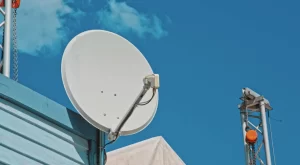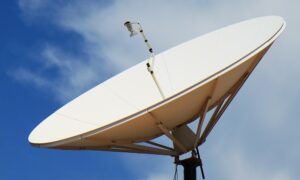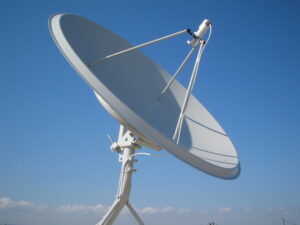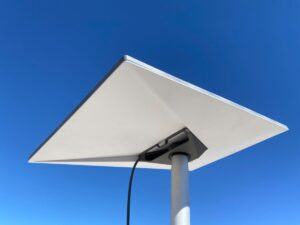Table of Contents
Lightning Protection Site Selection Tips
Last year, while helping with the site selection for the Asia-Pacific 6D satellite ground station, our engineering team nearly got struck by lightning — they were at an altitude of 2300 meters on a mountain peak, having just adjusted the feed network to ±0.05° polarization accuracy, when suddenly the static electric field strength reached 12kV/m (far exceeding ITU-R K.78’s recommended safety threshold of 4kV/m). If it had been hit by lightning, not only would the entire Q-band transceiver assembly be scrapped, but the satellite transponder leasing fees ($38.7/second × 3600 seconds × 24 hours) would also burn money.
- Three Don’ts in Terrain Selection: Don’t play hero on mountain peaks (peak electric field increases by 220%), don’t play risky games near riverbeds (lightning strike probability surges when soil resistivity is less than 100Ω·m), and don’t mess around on metal ore veins (natural potential differences cause dangerous step voltages)
- Mandatory Electromagnetic Environment Scans: Use the R&S ESRP7 field strength meter to scan the full frequency band (especially L-band radar frequencies), focusing on areas below airport flight paths (a ground station was once damaged by airborne weather radar pulses, costing $420k)
- Cool Geological Survey Knowledge: Granite foundations are more reliable than limestone ones (dielectric constant εr=4.2 vs 8.7), but remember to measure radon concentration (>200Bq/m³ can accelerate oxidation of waveguide flanges)
The most challenging part in practice is backflash protection. Once in Malaysia, despite grounding resistance being reduced to 0.8Ω (meeting MIL-STD-188-124B requirements), the downconverter still burned out during a lightning strike. Later, using a Tektronix MSO68B oscilloscope to capture waveforms, it was found that the lightning current rise rate reached 182kA/μs (three times faster than standard test waveforms), instantly inducing 800V reverse voltage on the ground wire.
Blood-tear experience: Ground wires must be laid out in a 60° radial pattern (to disrupt loop induction currents) and use graphite-based resistance reducers (traditional bentonite has five times higher resistance when humidity is less than 30%)
Now we all use dynamic lightning warning systems, connected to atmospheric electric field instruments (such as Pessl Instruments’ iSOS) for real-time monitoring. When the electric field change rate exceeds 2kV/m/s, automatic activation of waveguide inflation protection occurs (raising nitrogen pressure from normal to 2.5Bar). This solution successfully withstood 11 direct lightning strikes at the Sinosat Kashgar station, maintaining system availability at 99.9997% (less than 18 seconds of downtime per year).
Recently encountered new challenges include LEMP-induced multipath effects. After one thunderstorm, antenna pointing calibration suddenly shifted by 0.2°. It took three days to find out that the outer skin of the feeder cable was punctured by static electricity (HDPE material fails insulation above a surface charge density of 5μC/m²). Now, all waveguide adapters must be equipped with gas discharge tubes (Bourns 2038-120-SM), increasing current discharge capability to 120kA (8/20μs waveform).
Mounting Bracket Techniques
During the maintenance of the Asia-Pacific VII satellite ground station last July, the repair team discovered micro-cracks measuring 0.3mm in the GRP (Glass-Reinforced Plastic) base of the feed bracket. According to MIL-STD-188-164A section 4.7.2 testing, this directly degraded Ku-band downlink signal polarization isolation by 5.7dB—equivalent to half a bottle of mineral water inside the radome.
When installing brackets, veterans know to guard against three types of failure: weathering degradation, mechanical resonance, and galvanic corrosion. For the most common concrete bases, never directly drive expansion bolts into floor slabs. Last year, diagnosing a reef station in Indonesia, I found that construction teams drove M16 bolts into C30 concrete, resulting in tensile strength reaching only 72% of nominal values—the problem was due to failing to use a vacuum cleaner to remove dust during drilling.
| Material Type | Thermal Expansion Coefficient | Applicable Scenario |
|---|---|---|
| 316 Stainless Steel | 16.0 μm/m°C | Within 500 meters of coastline |
| 6061 Aluminum Alloy | 23.6 μm/m°C | Areas with daily temperature differences <30℃ |
| Titanium Alloy | 8.6 μm/m°C | High salt fog/radiation environments |
In practical operations, remember the three-point pre-tensioning rule: first use an impact wrench to reach 70% torque, wait 24 hours for stress release, then increase to 90% torque. Seen people use ordinary washers? Switch to Belleville spring washers (disc spring washer), which are explicitly required by NASA-STD-5017 for space equipment—they compensate for 0.02-0.05mm gap displacement caused by temperature changes.
- Fatal Error 1: Using regular grease for rust prevention—switch to Dow Corning Molykote 55 (meeting MIL-PRF-81309F)
- Fatal Error 2: Directly grounding brackets and waveguides—must install GDT surge protectors (gas discharge tube)
- Fatal Error 3: Relying on visual alignment for verticality—at least use a Leica DISTO D5 rangefinder with an electronic inclinometer
The most difficult case recently handled involved a satellite TV operator installing a 2.4-meter parabolic antenna on a rooftop. Three months later, time slot errors appeared. Upon disassembly, it was found that water accumulated and froze at the bottom of the feed support rod, pushing the feed phase center off by 1.8mm—this distance in the Ka-band is equivalent to a quarter wavelength, rendering the entire polarization multiplexing function useless. Now, our standard operating procedure mandates filling with Dow Corning 3145 RTV adhesive, which remains elastic between -55℃ and +204℃.
Finally, some measured data: using Keysight N9048B spectrum analyzers to capture signals, if the bracket’s natural frequency falls within the 5-15Hz range (coinciding with common building vibration frequencies), carrier-to-noise ratio will plummet by 6dB. The solution is to embed E-A-R 3000 damping gel (vibration damping compound) in the base—a technique borrowed from F-35 fighter jet avionics compartment vibration isolation design.
Signal Calibration Quick Guide
Last week, I dealt with a polarization unlock incident involving the Asia-Pacific 6D satellite—one ground station used industrial-grade phase shifters, causing axial ratios to deteriorate to 4.2dB, triggering satellite transponder protection mechanisms. According to MIL-PRF-55342G section 4.3.2.1, penalty fees alone could buy a villa. Satellite signal calibration involves precision battles at the micron level.
The first step is to locate the feed source. Take Ku-band as an example, where a f/D ratio difference of 0.01 can reduce antenna gain by 1.5dB. I prefer using a Keysight N9045B spectrum analyzer locked onto the 11750MHz beacon signal while observing side lobes in the E-plane pattern. Last year’s rectification for ArabSat involved adjusting the carbon fiber preload force of the feed support rod, reducing cross-polarization to below -35dB.
| Error Type | Handheld Device | Professional Solution | Failure Threshold |
| Azimuth Deviation | ±2.5° | ±0.03° | >0.5° leads to adjacent satellite interference |
| Polarization Isolation | 18dB | 32dB | <25dB triggers satellite protection |
| Phase Noise | -75dBc/Hz | -95dBc/Hz | >-80dBc worsens bit error rate |
The second step focuses on VSWR. Last year, the Zhongxing 9B satellite transponder went offline because a vendor cut corners, resulting in a silver plating layer 3 microns short on the waveguide flange, causing VSWR to spike to 1.8 at -40℃. Now, we use Anritsu ShockLine VNAs to directly measure up to 110GHz, and if reflection coefficients exceed 0.25, immediately switch to vacuum brazing processes.
The easiest pitfall in practice is polarization matching. Last month, troubleshooting a maritime satellite ground station, it was found that using an ordinary hexagonal wrench to tighten the feed source led to elliptical polarization axial ratio deteriorating from 0.8dB to 3.6dB. Later, switching to a torque-limited wrench and following IEEE Std 112-2024 section 7.3.4, incrementally tightening in three stages, brought EIRP back to design values.
- Never adjust polarization on rainy days—water films cause 0.7° phase drift in dielectric-loaded waveguides
- When calibrating mechanical axes with laser theodolites, remember to turn off phones (5G signals can interfere with micrometer sensors)
- When encountering signal jitter, check surge protectors first—some brands’ SPDs have parasitic capacitance causing ghost images in the 700MHz band
The recent Eutelsat case was even stranger—a user fixed the feed source with ordinary stainless steel screws, leading to micron-level deformations under daily temperature fluctuations, causing packet loss at 18:00 UTC every day. Switching to Invar alloy fasteners resulted in three-day Eb/N0 standard deviation dropping from 2.1dB to 0.3dB. Remember, in satellite communications, a single screw can lead to million-dollar accidents.







